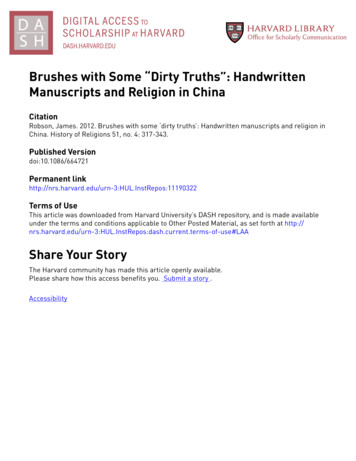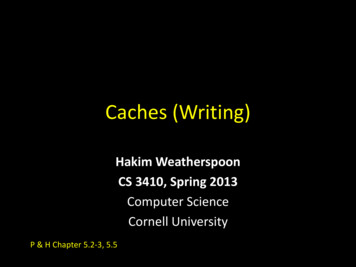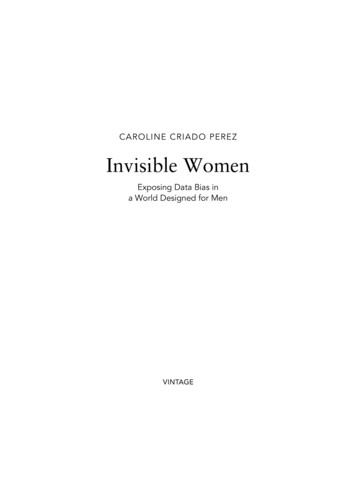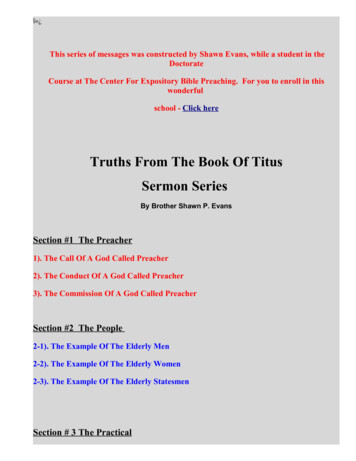
Transcription
Brushes with Some “Dirty Truths”: HandwrittenManuscripts and Religion in ChinaCitationRobson, James. 2012. Brushes with some ‘dirty truths’: Handwritten manuscripts and religion inChina. History of Religions 51, no. 4: 317-343.Published Versiondoi:10.1086/664721Permanent 90322Terms of UseThis article was downloaded from Harvard University’s DASH repository, and is made availableunder the terms and conditions applicable to Other Posted Material, as set forth at rrent.terms-of-use#LAAShare Your StoryThe Harvard community has made this article openly available.Please share how this access benefits you. Submit a story .Accessibility
Brushes with Some “Dirty Truths”: Handwritten Manuscripts and Religion in ChinaAuthor(s): James RobsonSource: History of Religions, Vol. 51, No. 4 (May 2012), pp. 317-343Published by: The University of Chicago PressStable URL: http://www.jstor.org/stable/10.1086/664721 .Accessed: 28/05/2013 20:45Your use of the JSTOR archive indicates your acceptance of the Terms & Conditions of Use, available at ms.jsp.JSTOR is a not-for-profit service that helps scholars, researchers, and students discover, use, and build upon a wide range ofcontent in a trusted digital archive. We use information technology and tools to increase productivity and facilitate new formsof scholarship. For more information about JSTOR, please contact support@jstor.org.The University of Chicago Press is collaborating with JSTOR to digitize, preserve and extend access to Historyof Religions.http://www.jstor.orgThis content downloaded from 171.66.240.76 on Tue, 28 May 2013 20:45:14 PMAll use subject to JSTOR Terms and Conditions
James RobsonBRUSHES WITH SOME“DIRTY TRUTHS”:HANDWRITTENMANUSCRIPTS ANDRELIGION IN CHINACatherine Bell is best known to scholars outside of the study of Chinese religions as a perceptive reader and interpreter of ritual theory, for her studies ofthe category of “belief,” and for her innovative approaches to religious studiesas a discipline.1 Yet, in her Ritual Theory, Ritual Practice she claimed that itall began with her doctoral work in Daoist studies and that the “problems andissues engaged” in that book “were first formulated for a dissertation chapter.”2 Among Sinologists and scholars of Asian religions she is appreciatedfor the service she provided by reviewing—often in the pages of this journal—influential new works on Chinese Daoism and “popular religion,” althoughthose essays were more ambitious than mere “reviews,” since they raised keymethodological issues that helped move the field forward.3 Her focused and1See, e.g., Catherine Bell, Ritual Theory, Ritual Practice (New York: Oxford University Press,1992), Ritual: Perspectives and Dimensions (New York: Oxford University Press, 1997), “Performance,” in Critical Terms for Religious Studies, ed. Mark C. Taylor (Chicago: University of Chicago Press, 1998), 205–24, “Modernism and Postmodernism in the Study of Religion,” ReligiousStudies Review 22, no. 3 (July 1996): 179–90, and “Paradigms Behind (and Before) the ModernConcept of Religion,” History and Theory 45 (December 2006): 27– 46.2Bell, Ritual Theory, Ritual Practice, vii, and Catherine Bell, “Medieval Taoist Ritual Mastery: A Study in Practice, Text, and Rite” (PhD diss., University of Chicago, 1983).3Catherine Bell, “In Search of the Tao in Taoism: New Questions of Unity and Multiplicity,”History of Religions 33, no. 2 (November 1993): 187–201, and “Religion and Chinese Culture:Toward an Assessment of ‘Popular Religion’,” History of Religions 29, no. 1 (August 1989): 35–57.Ó 2012 by The University of Chicago. All rights reserved.0018-2710/2012/5104-0003 10.00This content downloaded from 171.66.240.76 on Tue, 28 May 2013 20:45:14 PMAll use subject to JSTOR Terms and Conditions
318Brushes with Some “Dirty Truths”detailed historical and textual work on the various editions of and commentaries on the Tract of the Most Exalted on Action and Retribution (Taishangganying pian), a “morality book” dating from the twelfth centurythat she spent much of her truncated career translating and studying, also garnered attention among scholars of Chinese history and religion.4 CatherineBell’s work on Daoist ritual (especially Lingbao liturgy), and Chinese religions more generally, opened up new lines of inquiry, and the field anxiouslyanticipated the day when she would bring together in a more systematic wayher work as a theorist and her work as a scholar of Chinese religions.5Given the amount of attention that has been directed at Bell’s work on ritual and ritual theory, in the space allotted to me here I would like to bracketthose topics and draw inspiration instead from a different facet of her work.One of the topics that surfaced again and again in a number of her essays, suchas her “Printing and Religion in China,” which inspired the title of the presentessay, was the relationship between the development of printing technologyin China and Chinese religions. Bell noted the obvious ways printing couldfoster the spread of religious ideas, but she also pointed out how that newmedium could ossify the development of a religious tradition. Bell’s work onreligion and print is a topic sure to be less familiar to those outside the innercircles of Sinology, but it is also work that has not yet attracted the attention itdeserves among scholars of Chinese religions, and it invites reflection onother larger questions in the study of religion.64Catherine Bell, “Printing and Religion in China: Some Evidence from the Taishang ganyingpian,” Journal of Chinese Religions 20 (Fall 1992): 173–86, “‘A Precious Raft to Save the World’:The Interaction of Scriptural Traditions and Printing in a Chinese Morality Book,” Late ImperialChina 17, no. 1 (1996): 158–200, and “Stories from the Illustrated Explanation of the Tract of theMost Exalted on Action and Response,” in Religions of China in Practice, ed. Donald S. Lopez Jr.(Princeton, NJ: Princeton University Press, 1996), 437–70. In her first two published writings onas Treatise of the Mostthe text she translates the title of the Taishang ganying pianHigh on Action and Retribution.5Glimpses of work in that direction can be found in Catherine Bell, “Ritualization of Texts andTextualization of Ritual in the Codification of Taoist Liturgy,” History of Religions 27, no. 4 (May1988): 366–92, “Performance,” 205–24, and “‘The Chinese Believe in Spirits’: Belief and Believing in the Study of Religion,” in Radical Interpretation in Religion, ed. Nancy K. Frankenberry(Cambridge: Cambridge University Press, 2002), 100–116.6This is not to say, however, that Bell’s work on Daoist ritual and “popular religion” has nothad an impact in the field. Her work on Daoism, especially her “Ritualization of Texts and Textualization of Ritual in the Codification of Taoist Liturgy,” has been, and still is, regularly cited byscholars of Daoism. See, for instance, Anna Seidel, “Chronicle of Taoist Studies in the West,1950–1990,” Cahiers d’Extr eme-Asie 5 (1990): 267; Kenneth Dean, Taoist Ritual and PopularCults of Southeast China (Princeton, NJ: Princeton University Press, 1993), 177; Stephen Bokenkamp, “Lu Xiujing, Buddhism and the First Daoist Canon,” in Culture and Power in the Reconstitution of the Chinese Realm, 200–600, ed. Scott Pearce, Audrey Spiro, and Patricia Ebrey (Cambridge, MA: Harvard University Asia Center, 2001), 189–90 and 316 n. 34; Edward L. Davis,Society and the Supernatural in Song China (Honolulu: University of Hawaii Press, 2001), 307;L u Pengzhi, “Daoist Rituals,” in Early Chinese Religions Part Two: The Period of DivisionThis content downloaded from 171.66.240.76 on Tue, 28 May 2013 20:45:14 PMAll use subject to JSTOR Terms and Conditions
History of Religions319It is not plausible in the confines of this essay to fully contextualize this discussion within the now voluminous body of material on the history of thedevelopment of printing and the history of the book in East Asia.7 Given theimportant place of China in the history of printing—with the oldest extantprinted book in the world being an edition of the Diamond S utra dated to 868CE—it is natural that the focus of most scholarship has heretofore been onprinting, book culture, publishing, and distribution. Yet, other important questions remain to be addressed. Was there, for instance, a print revolution inChina that brought an end to manuscript production? Clearly the British historian of science Joseph Needham’s claim that following the invention andspread of printing “practically everything in Chinese is either printed or lost”is an untenable historical assessment.8 The surviving collections of Chinese(220–589), ed. John Lagerwey and L u Pengzhi (Leiden: Brill Academic, 2010), 1246– 47. Herwork on Chinese “popular religion” has been engaged, for example, by Stephen F. Teiser, “Popular Religion,” Journal of Asian Studies 54, no. 2 (May 1995): 378–95; Bernard Faure, The Rhetoricof Immediacy: A Cultural Critique of Chan/Zen Buddhism (Princeton, NJ: Princeton UniversityPress, 1991), 299–301 and 311–14; and Kenneth Dean, Lord of the Three in One: The Spread of aCult in Southeast China (Princeton, NJ: Princeton University Press, 1998), 10–11. For the mostrecent, and perhaps most explicit, engagement with her work, see David John Mozina, “Quellingthe Divine: The Performance of a Talisman in Contemporary Thunder Ritual” (ThD dissertation,Harvard University, 2009).7For a more complete discussion of some of these issues, see James Robson, “The ArchiveInside: Manuscripts Found within Chinese Religious Statues,” in Manuscript Culture in Asia, ed.Jörg Quencer, Michael Friedrich, Matthew Driscoll, and Jan-Ulrich Sobisch (Berlin: de Gruyter,forthcoming), on which some of the sections of this essay are based. On the history of printing andpublishing in China, see, among others, T. H. Barrett, The Woman Who Discovered Printing (NewHaven, CT: Yale University Press, 2008); Cynthia Brokaw and Kai-Wing Chow, eds., Printing andBook Culture in Late Imperial China (Berkeley: University of California Press, 2005); MichelaBussotti, Gravures de l’e cole de Hui: Etude du livre illustré chinois de la fin du XVIe si ecle aumilieu du XVIIe si ecle (Paris: EFEO, 2001); Thomas Francis Carter, The Invention of Printing inChina and Its Spread Westward, ed. L. Carrington Goodrich, rev. ed. (1925; repr., New York:Ronald Press, 1955); Susan Cherniack, “Book Culture and Textual Transmission in Sung China,”Harvard Journal of Asiatic Studies 54, no. 1 (1994): 5–125; Lucille Chia, Printing for Profit: TheCommercial Publishers of Jianyang, Fujian (11th–17th Centuries) (Cambridge, MA: Harvard University Asia Center, 2002); Jean-Pierre Dr ege, Les biblioth eques en Chine au temps des manuscripts (Paris: École française d’Extr eme-Orient, 1991); J. S. Edgren, “China,” in A Companion tothe History of the Book, ed. Simon Eliot and Jonathan Rose (Oxford: Wiley-Blackwell, 2007), 97–110; M. R. Guignard, “The Chinese Precedent,” in The Coming of the Book, ed. Lucien Febvre andHenri-Jean Martin (London: Verso, 1976), 71–76; Berthold Laufer, Paper and Printing in AncientChina (New York: Franklin, 1973); Joseph P. McDermott, A Social History of the Chinese Book:Books and Literati Culture in Late Imperial China (Hong Kong: Hong Kong University Press,2006); Frederick W. Mote and Hung-lam Chu, Calligraphy and the East Asian Book (Boston:Shambhala, 1989); Tsuen-hsuin Tsien, Written on Bamboo and Silk: The Beginnings of ChineseBooks and Inscriptions (Chicago: University of Chicago Press, 1962), and Science and Civilizationin China, vol. 5, Chemistry and Chemical Technology, pt. 1, Paper and Printing, ed. Joseph Needham (Cambridge: Cambridge University Press, 1985); and Denis Twitchett, Printing and Publishing in Medieval China (London: De Worde Society, 1983). See also the special issue of Late Imperial China 17, no. 1 (June 1996) devoted to “Publishing and the Print Culture in Late ImperialChina,” which includes Roger Chartier’s introduction “Gutenberg Revisited from the East,” 1–9.8Joseph Needham, “The Unity of Science: Asia’s Indispensable Contribution,” in Clerks andCraftsmen in China and the West (Cambridge: Cambridge University Press, 1970), 24.This content downloaded from 171.66.240.76 on Tue, 28 May 2013 20:45:14 PMAll use subject to JSTOR Terms and Conditions
320Brushes with Some “Dirty Truths”handwritten manuscripts that include, among other forms, literary, political,religious, ritual, and dramatic writing suggest otherwise. Manuscripts remained in production and use long after the advent of print. Writing about thepersistence and importance of manuscript culture in the context of medievalChinese literature, Xiaofei Tian has claimed that “hand copying a book maybe a practice quite alien to us now, but it was the single most important meansof transmission of knowledge and information in the age of manuscript culture” and that “copying texts by hand was, moreover, practiced throughoutimperial China, despite the spread of printing.”9 The rise of printing technology certainly had a major impact on textual practices by making books lessexpensive and more readily available, but that should not lead us to concludethat there were no practical reasons for the continuation of manuscript production. Certain historical and cultural factors ensured that handwritten manuscripts remained in production and even that some books only circulated inmanuscript form. J. S. Edgren, commenting on the status of manuscripts following the acceleration of printing technology during the Northern SongDynasty (960–1125), has noted that “collections of manuscripts were not suddenly eclipsed by printed books. For one thing, conservative scholars wereskeptical of the textual quality of the impersonal printed products; for another,good-quality books were rather expensive. No matter the rapid growth ofprinting, many desirable titles were not in print and could only be obtained bymaking manuscript copies.”10Utilitarian explanations for the persistence of manuscript production in theage of print should not be taken lightly, though we would do well to recognizethat other cultural and aesthetic factors may have been involved. FrederickMote has pointed out that “the aesthetics of calligraphy, which flourishedgreatly in the Tang period, not only influenced the design of printed books,but also found still more direct expression in the creation of manuscript books9Xiaofei Tian, Tao Yuanming and Manuscript Culture: The Record of the Dusty Table (Seattle: University of Washington Press, 2005), 4 and 221. See also Chia (Printing for Profit, 11–12and 40– 42), who notes that there was “an enduring interaction of manuscript and print in China,”and Cherniack (“Book Culture,” 10), who argues for the increasing importance of imprints duringthe Song but also remarks that “although Song printers were prolific, the majority of books in Songimperial and private libraries were still manuscripts.”10Edgren, “China,” 102. See also Frederick W. Mote, “Handwritten Books after the Inventionof Printing,” in Mote and Chu, Calligraphy and the East Asian Book, 76–77. Joseph McDermotthas questioned the speed with which manuscripts were surpassed by imprints and makes theimportant observation that before general conclusions are drawn about the nature of that transitionmore research is necessary on the relative numbers of manuscripts, since as yet “very little systematic research has been undertaken on the history of manuscripts in the Song or any later dynasty”(“The Ascendance of the Imprint in China,” in Brokaw and Chow, Printing and Book Culture inLate Imperial China, 60). On the persistence of manuscripts following the rise of printing see also, “Shuppan bunka to gakujitsu” [The culture of publishing and scholarship],Inoue Susumu[Basic questions in the history of thein Min Shin jidai no kihon mondaiet al. (Tokyo: Ky uko shoin, 1997), 531–55.Ming and Qing periods], ed. Mori MasaoThis content downloaded from 171.66.240.76 on Tue, 28 May 2013 20:45:14 PMAll use subject to JSTOR Terms and Conditions
History of Religions321. . . superior calligraphers seem to have been all the more drawn to creatinghandwritten books as works of art.”11 In addition to the practical, utilitarian,and aesthetic explanations for the persistence of secular manuscript culture,we will see below that certain religious factors—particularly the sacred powers inherent in handwritten script and devotional practices related to meritmaking—played an important role in keeping the tradition of producing handwritten manuscripts alive and well.Some types of handwritten texts were never destined to be printed, norwere they merely produced as copies of unobtainable printed works or forreaders to enjoy the aesthetic quality of the copyist’s calligraphy. When welimit our purview to that of local village life, new evidence of handwrittenmanuscripts comes into view. In a study of handwritten materials in villagesin the New Territories of Hong Kong—based on fieldwork undertaken in thelate 1970s, James Hayes begins by discussing how the ravages of historicaland climatic conditions had taken their toll on the survival of manuscripts. Heexpresses surprise that manuscripts survived at all and concludes that “theirendurance can only be attributed to the great store their owners set by them.”12Hayes goes on to note how these types of materials “represent a new body ofresearch material that has much to add to our conception of traditional Chinese society in the countryside and its social and political organization.”13The types of handwritten texts in use in the context of local daily life can besorted into three main categories:14 (1) books and handbooks (including genealogical records, handbooks of family and social practice, almanacs, educational texts, letter writing guides, guides to contracts, poetry, novels, andmorality books); (2) books provided for and by specialists (including thosethat deal with human fate, geomancy, charms, and divination); and (3) writtenmaterials providing the cultural and social context of daily life (includingsigns, notices, ephemera, and placards). We are now also aware of the fact thateven up through the modern period handwritten manuscripts of short stories11Mote, “Handwritten Books,” 76–77.James Hayes, “Specialists and Written Materials in the Village World,” in Popular Culturein Late Imperial China, ed. David Johnson, Andrew J. Nathan, and Evelyn Rawski (Berkeley: University of California Press, 1985), 76–77.13Hayes, “Specialists and Written Materials,” 77. Hayes’s optimism was certainly justified, asattested by the work of (among others) Rubie S. Watson, Inequality among Brothers: Class andKinship in South China (Cambridge: Cambridge University Press, 1985); David Faure, The Structure of Chinese Rural Society: Lineage and Village in the Eastern New Territories, Hong Kong(Oxford: Oxford University Press, 1986); David Faure and Helen F. Siu, eds., Down to Earth: TheTerritorial Bond in South China (Stanford, CA: Stanford University Press, 1995); Zheng Zhenman, Family Lineage Organization and Social Change in Ming and Qing Fujian, trans. MichaelSzonyi, with Kenneth Dean and David Wakefield (Honolulu: University of Hawaii Press, 2001);and Michael Szonyi, Practicing Kinship: Lineage and Descent in Late Imperial China (Stanford,CA: Stanford University Press, 2002).14This list is adapted from Hayes, “Specialists and Written Materials,” 78–110.12This content downloaded from 171.66.240.76 on Tue, 28 May 2013 20:45:14 PMAll use subject to JSTOR Terms and Conditions
322Brushes with Some “Dirty Truths”and other types of literature remained in circulation, despite their proscriptionduring the Cultural Revolution.15 This wealth of evidence forces us, therefore,to revise Joseph Needham’s problematic claim about the hegemony of printfollowing its development and spread in the ninth century.It is possible to track the technological developments from handwrittentexts, to woodblock printing, to printing with moveable type—and yet thereis an alternative history of handwritten manuscripts that remains to be composed. As was the case with the history of handwritten texts after the Gutenberg revolution in the West, the practice of producing handwritten versions oftexts persisted alongside the new technology of printing and has endured untiltoday, much like the important handwritten signature in our digital age.16 Thefield of Sinology is, however, only slowly approaching a state where we mightbe able to one day claim, in the words of Bernard Cerquiglini, that “the manuscript, which has long been pushed to the margins of legitimate reflection andsometimes even obliterated—the abominable trace of some positivist concern—is now the latest object of analysis.”17 We await foundational studies thatwill help synthesize some of the different strands of research that have beencompleted to date.One blind spot in the study of printing and book culture in China is its relationship to religious history and religious practices. As Cynthia Brokaw hasnoted, “surprisingly little work has been done on the impact of printing onreligious reading practices and beliefs, though Catherine Bell has begun tomine this potentially rich field with a few suggestive articles on the ways inwhich printing, while expanding the possibilities for proselytization, mightalso operate to fix and thus limit the flexibility of religious doctrines.”18 Thismention of Bell’s work on the critical analysis of the impact of printing onChinese religions demonstrates her engagement with an important topic andhow she was ahead of her time in asking such questions. Her work prefigureda movement within the field that recognizes the limitations of working solelywith incunabula. Some scholars have begun to pay more attention to handwritten manuscripts in use after the invention and spread of printing. This new15On the circulation of handwritten literature during the Cultural Revolution see Perry Link,“Hand-Copied Entertainment Fiction from the Cultural Revolution,” in Unofficial China: PopularCulture and Thought in the People’s Republic, ed. Perry Link, Richard Madsen, and Paul G. Pickowicz (Boulder, CO: Westview, 1989), 17–36.16See Elizabeth L. Eisenstein, The Printing Revolution in Early Modern Europe (Cambridge:Cambridge University Press, 1983); and Brian Richardson, Manuscript Culture in RenaissanceItaly (Cambridge: Cambridge University Press, 2009). On the “signature,” see Béatrice Frenkel,La signature: Gen ese d’un signe (Paris: Gallimard, 1992).17Bernard Cerquiglini, In Praise of the Variant: A Critical History of Philology (Baltimore:Johns Hopkins University Press, 1999), i.18Cynthia Brokaw, “On the History of the Book in China,” in Brokaw and Chow, Printing andBook Culture in Late Imperial China, 42.This content downloaded from 171.66.240.76 on Tue, 28 May 2013 20:45:14 PMAll use subject to JSTOR Terms and Conditions
History of Religions323emphasis does not deny the profound impact that printing had in China, butthe shift in focus to handwritten texts allowed access to less-studied domainsof Chinese religious practice. Those materials also force us to grapple withsome intractable issues regarding category formation in the study of Chinesereligions, a topic that was of fundamental importance to Bell.19Bell seems to have been drawn to the topic of printing and religion throughher work on the Taishang ganying pian (Tract of the most exalted on actionand retribution). In contextualizing that text with a critical discussion of therelationship between printing and religion in Europe, Bell raised three mainquestions that she posited as being equally applicable to the Chinese context:(1) Did printing constitute a revolution in European culture? (2) How did religion, as a major consumer and supporter of printing, change through its use ofthis new medium? (3) Was printing ultimately a force for sociocultural unityor division?20 What Bell discovered in pursuing these questions was thatalthough printing technology certainly did have an impact in China, includingin the domain of religion—especially in regard to the mass distribution ofmorality books—“printing in China never displaced hand copying the way itdid in Europe. At the very least, hand copying persisted as an important firststep for woodblock printing or stone engraving.”21 The Taishang ganyingpian, in her interpretation, was therefore not an example of the success of a“printing revolution” but was distinctive due to its innovative claim about thereligious efficacy and merit-making potential of its own dissemination.22Although Bell relegated the handwritten manuscript to the status of being amere preparatory aide in the printing process, it is now clear that—just as in thecase of secular manuscript culture—religious manuscripts retained a special status and continued to be produced even when not destined to be printed. Handwritten religious manuscripts have, however, received less attention than theydeserve due to a primary focus among scholars on the history of the relationshipbetween Buddhism and the invention and development of printing technologyin China from about the seventh century onward.23 The printing of individual19See, e.g., Bell, “The Chinese Believe in Spirits,” and “Paradigms Behind (and Before).”Bell, “Printing and Religion in China,” 173.21Ibid., 176.22Of course, as Bell herself concedes (“Precious Raft,” 170, 175), “a Buddhist ‘cult of thebook’ long predated the earliest copy of the Treatise,” but she argues that the Treatise “pushed thesignificance of distribution much further.” On the Buddhist cult of the book, see, among others,Gregory Schopen, “The Phrase ‘sa pṛthiv ıprade sa s caityabh uto bhavet’ in the Vajracchedik a:Notes on the Cult of the Book in Mah ay ana,” Indo-Iranian Journal 17 (1975): 147–81.23See, however, the comments on the importance of handwritten manuscripts by Barrett, TheWoman Who Discovered Printing, especially chap. 3; and the important earlier articles by Kristofer M. Schipper, “The Written Memorial in Taoist Ceremonies,” in Religions and Ritual in Chinese Society, ed. Arthur P. Wolf (Stanford, CA: Stanford University Press, 1974), 309–24, whichdiscuss the importance of “manuscript” versions of Daoist ritual documents, and “Vernacular and20This content downloaded from 171.66.240.76 on Tue, 28 May 2013 20:45:14 PMAll use subject to JSTOR Terms and Conditions
324Brushes with Some “Dirty Truths”religious texts and complete canons accelerated rapidly from the tenth centuryto the present, but that trend did not result in the eradication of manuscript culture either.24 Indeed, one could mount a persuasive argument that the most significant developments in the contemporary study of Chinese religions havebeen ignited by the discovery and study of surviving manuscript collections.The most influential discovery of the past century was, of course, that ofthe rich cache of manuscripts found at Dunhuang, an important SilkRoad outpost in far western China.25 Although the discovery of a printed edition of the Diamond S utra in those caves has attracted an inordinate amount ofattention, since it is dated to 868 and therefore considered to be the oldestdated printed book in the world (though other printed materials already existedand are also attested in Korea and Japan), the printed materials found in thatcache are in fact far outnumbered by handwritten manuscripts.26 The Dunhuang discoveries, and other discoveries of manuscripts at Turfan and otherlocales in western China, invigorated the study of Chinese manuscripts, especially in the fields of Buddhist and Daoist studies, apocryphal texts, philology,astronomy, divination, calendrics, social history, politics, and legal history.27Classical Ritual in Taoism,” Journal of Asian Studies 45, no. 1 (1985): 21–57. I will have more tosay on this topic below.24Fang Guangchang, Zhongguo xieben dazangjing yanjiu[Research on handwritten manuscripts of the Buddhist canon] (Shanghai: Shanghai guji chubanshe, 2006).25For an engaging tale of their discovery, see Peter Hopkirk, Foreign Devils on the Silk Road:The Search for the Lost Cities and Treasures of Chinese Central Asia (Amherst: University ofMassachusetts Press, 1980). For detailed studies on the general characteristics of the find, seeFujieda Akira, “The Tun-huang Manuscripts: A General Description,” Zinbun: Memoirs of theResearch Institute for Humanistic Studies, Ky ot o University 9 (1966): 1–32, and 10 (1969): 17–39; Rong Xinjiang, “The Nature of the Dunhuang Library Cave and the Reason for Its Sealing,”Cahiers d’Extr eme-Asie 11 (1999–2000): 247–75; and most recently Yoshiro Imaeda, “The Provenance and Character of Dunhuang Documents,” Memoirs of the Toyo Bunko 66 (2008): 81–102.26On the printed books found at Dunhuang and the existence of the oldest printed document inKorea, see, for instance, Twitchett, Printing and Publishing, 18–26; and Carter, Invention of Printing in China, 37–66.27The secondary literature on the study of Dunhuang Buddhist manuscripts is too vast to citecompletely here, but see, for example, Wendi Leigh Adamek, The Mystique of Transmission: OnEarly Chan History and Its Contexts (New York: Columbia University Press, 2007); JeffreyBroughton, The Bodhidharma Anthology: The Earliest Records of Zen (Berkeley: University ofCalifornia Press, 1999); Robert E. Buswell Jr., ed., Chinese Buddhist Apocrypha (Honolulu: University of Hawaii Press, 1990); Paul Demiéville, Le concile de Lhasa (Paris: Imprimerie Nationalede France, 1952), Choix d’e tudes bouddhiques, 1929–1970 (Leiden: Brill Academic Publishing,1973); Jean-Pierre Dr ege, ed., Images de Dunhuang: Dessins et peintures sur papier des fond Pelliot et Stein (Paris: École française d’Extr eme-
Brushes with Some "Dirty Truths": Handwritten Manuscripts and Religion in China Citation Robson, James. 2012. Brushes with some 'dirty truths': Handwritten manuscripts and religion in China. History of Religions 51, no. 4: 317-343. . good-quality books were rather expensive. No matter the rapid growth of










